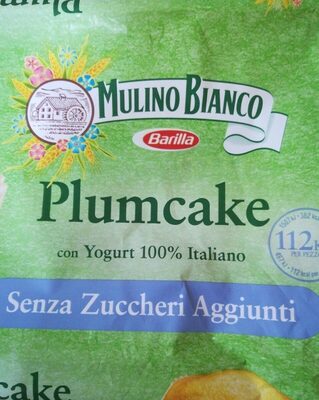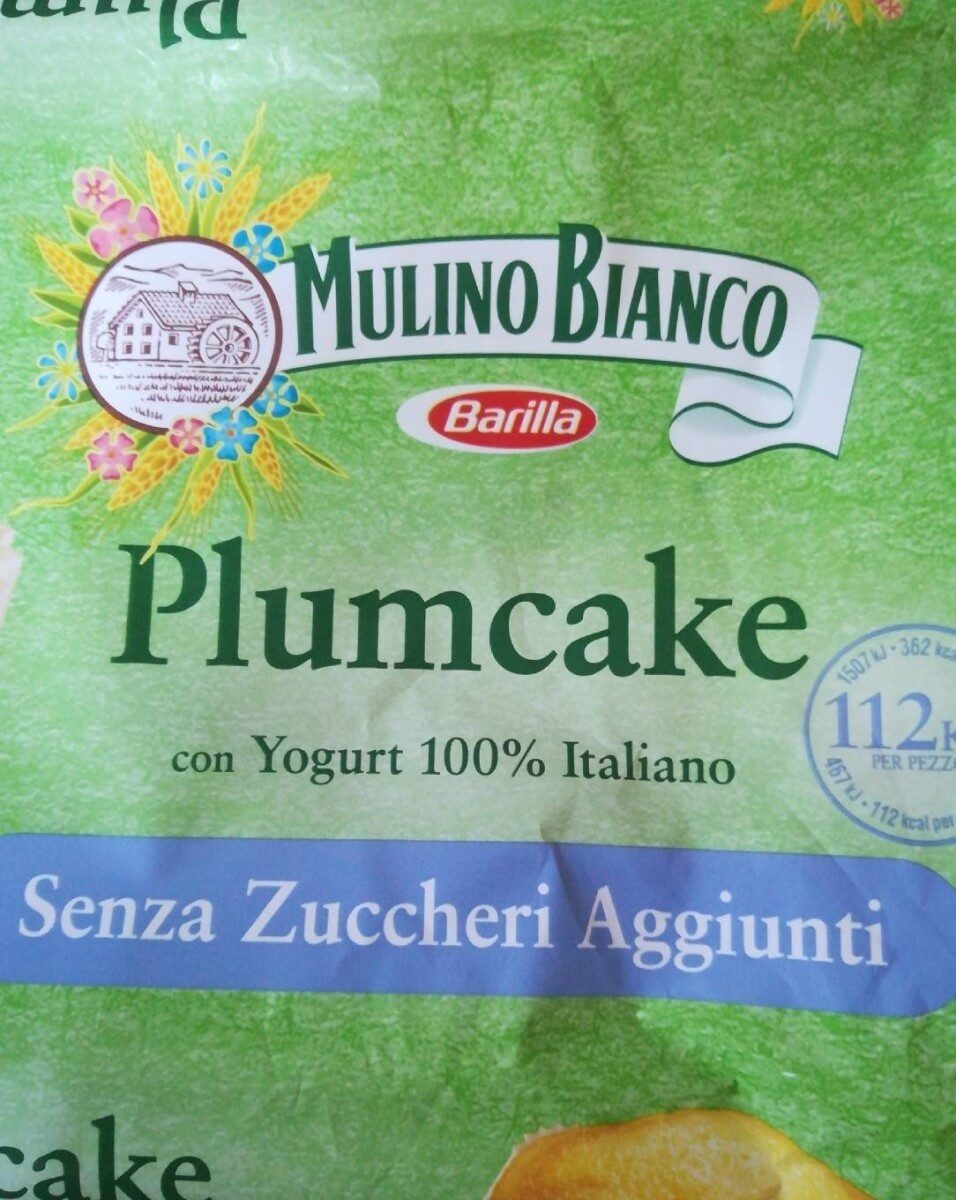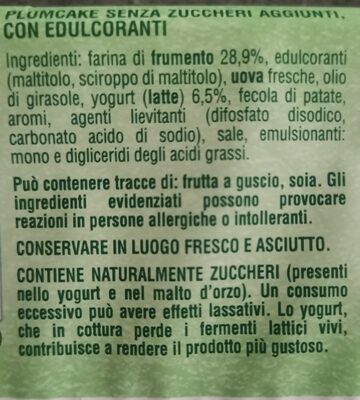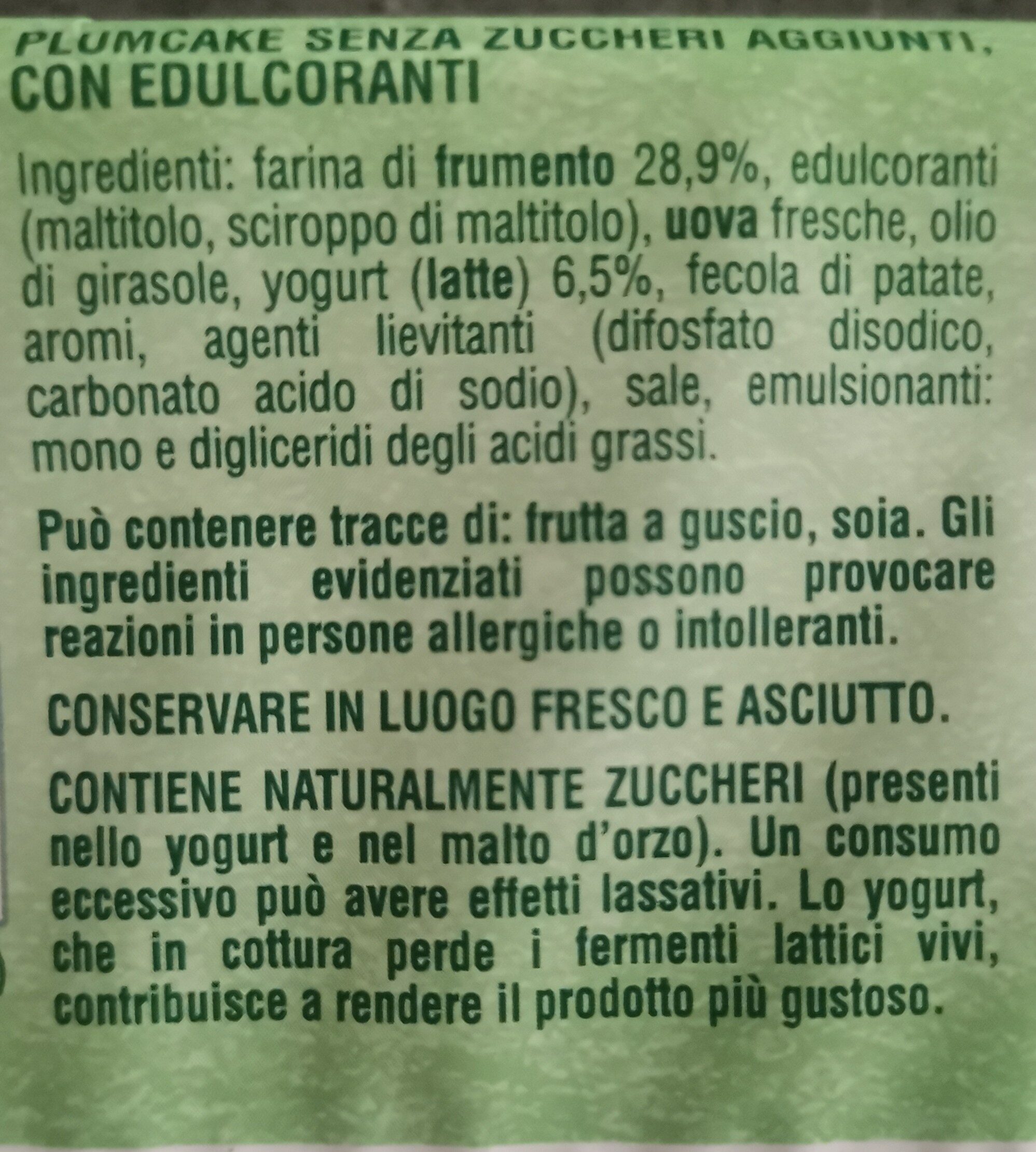Help us make food transparency the norm!
As a non-profit organization, we depend on your donations to continue informing consumers around the world about what they eat.
The food revolution starts with you!
Plumcake - Mulino Bianco - 155 g
Plumcake - Mulino Bianco - 155 g
This product page is not complete. You can help to complete it by editing it and adding more data from the photos we have, or by taking more photos using the app for Android or iPhone/iPad. Thank you!
×
Barra-kodea: 8076809574303 (EAN / EAN-13)
Kopurua: 155 g
Ontziratzea: en:Plastic, 22 PAP, it:Indifferenziata
Markak: Mulino Bianco, Mulino bianco
Kategoriak: en:Snacks, en:Sweet snacks, en:Biscuits and cakes, Gozopil, en:Pound Cake
Etiketak, ziurtagiriak, sariak: No added sugar, en:No palm oil
Dendak: Esselunga
Matching with your preferences
Health
Osagaiak
-
16 ingredients
: Farina di frumento 28,9%, edulcoranti (maltitolo, sciroppo di maltitolo), uova fresche, olio di girasole, yogurt (latte) 6,5%, fecola di patate, aromi, agenti lievitanti (difosfato disodico, carbonato acido di sodio), sale, emulsionanti: mono e digliceridi degli acidi grassi. Può contenere tracce di: frutta a guscio, soia. Gli ingredienti evidenziati possono provocare reazioni in persone allergiche o intolleranti.Alergenoak: en:Gluten, en:MilkAztarnak: en:Nuts, en:Soybeans
Food processing
-
Ultra processed foods
Elements that indicate the product is in the 4 - Ultra prozesatutako elikagaiak eta edariak group:
- Gehigarria: E450
- Gehigarria: E471
- Gehigarria: E965
- Osagaia: Emulsifier
- Osagaia: Flavouring
- Osagaia: Sweetener
Food products are classified into 4 groups according to their degree of processing:
- Prozesatu gabeko edo ahalik eta gutxien prozesatutako elikagaiak
- Sukaldaritzako osagaiak prozesatu
- Prozesatutako jakiak
- Ultra processed foods
The determination of the group is based on the category of the product and on the ingredients it contains.
Gehigarriak
-
E471
Mono- and diglycerides of fatty acids: Mono- and diglycerides of fatty acids -E471- refers to a food additive composed of diglycerides and monoglycerides which is used as an emulsifier. This mixture is also sometimes referred to as partial glycerides.Source: Wikipedia (Ingeles)
-
E500
Sodium carbonate: Sodium carbonate, Na2CO3, -also known as washing soda, soda ash and soda crystals, and in the monohydrate form as crystal carbonate- is the water-soluble sodium salt of carbonic acid. It most commonly occurs as a crystalline decahydrate, which readily effloresces to form a white powder, the monohydrate. Pure sodium carbonate is a white, odorless powder that is hygroscopic -absorbs moisture from the air-. It has a strongly alkaline taste, and forms a moderately basic solution in water. Sodium carbonate is well known domestically for its everyday use as a water softener. Historically it was extracted from the ashes of plants growing in sodium-rich soils, such as vegetation from the Middle East, kelp from Scotland and seaweed from Spain. Because the ashes of these sodium-rich plants were noticeably different from ashes of timber -used to create potash-, they became known as "soda ash". It is synthetically produced in large quantities from salt -sodium chloride- and limestone by a method known as the Solvay process. The manufacture of glass is one of the most important uses of sodium carbonate. Sodium carbonate acts as a flux for silica, lowering the melting point of the mixture to something achievable without special materials. This "soda glass" is mildly water-soluble, so some calcium carbonate is added to the melt mixture to make the glass produced insoluble. This type of glass is known as soda lime glass: "soda" for the sodium carbonate and "lime" for the calcium carbonate. Soda lime glass has been the most common form of glass for centuries. Sodium carbonate is also used as a relatively strong base in various settings. For example, it is used as a pH regulator to maintain stable alkaline conditions necessary for the action of the majority of photographic film developing agents. It acts as an alkali because when dissolved in water, it dissociates into the weak acid: carbonic acid and the strong alkali: sodium hydroxide. This gives sodium carbonate in solution the ability to attack metals such as aluminium with the release of hydrogen gas.It is a common additive in swimming pools used to raise the pH which can be lowered by chlorine tablets and other additives which contain acids. In cooking, it is sometimes used in place of sodium hydroxide for lyeing, especially with German pretzels and lye rolls. These dishes are treated with a solution of an alkaline substance to change the pH of the surface of the food and improve browning. In taxidermy, sodium carbonate added to boiling water will remove flesh from the bones of animal carcasses for trophy mounting or educational display. In chemistry, it is often used as an electrolyte. Electrolytes are usually salt-based, and sodium carbonate acts as a very good conductor in the process of electrolysis. In addition, unlike chloride ions, which form chlorine gas, carbonate ions are not corrosive to the anodes. It is also used as a primary standard for acid-base titrations because it is solid and air-stable, making it easy to weigh accurately.Source: Wikipedia (Ingeles)
-
E500ii - Sodio hidrogenokarbonato
Sodium carbonate: Sodium carbonate, Na2CO3, -also known as washing soda, soda ash and soda crystals, and in the monohydrate form as crystal carbonate- is the water-soluble sodium salt of carbonic acid. It most commonly occurs as a crystalline decahydrate, which readily effloresces to form a white powder, the monohydrate. Pure sodium carbonate is a white, odorless powder that is hygroscopic -absorbs moisture from the air-. It has a strongly alkaline taste, and forms a moderately basic solution in water. Sodium carbonate is well known domestically for its everyday use as a water softener. Historically it was extracted from the ashes of plants growing in sodium-rich soils, such as vegetation from the Middle East, kelp from Scotland and seaweed from Spain. Because the ashes of these sodium-rich plants were noticeably different from ashes of timber -used to create potash-, they became known as "soda ash". It is synthetically produced in large quantities from salt -sodium chloride- and limestone by a method known as the Solvay process. The manufacture of glass is one of the most important uses of sodium carbonate. Sodium carbonate acts as a flux for silica, lowering the melting point of the mixture to something achievable without special materials. This "soda glass" is mildly water-soluble, so some calcium carbonate is added to the melt mixture to make the glass produced insoluble. This type of glass is known as soda lime glass: "soda" for the sodium carbonate and "lime" for the calcium carbonate. Soda lime glass has been the most common form of glass for centuries. Sodium carbonate is also used as a relatively strong base in various settings. For example, it is used as a pH regulator to maintain stable alkaline conditions necessary for the action of the majority of photographic film developing agents. It acts as an alkali because when dissolved in water, it dissociates into the weak acid: carbonic acid and the strong alkali: sodium hydroxide. This gives sodium carbonate in solution the ability to attack metals such as aluminium with the release of hydrogen gas.It is a common additive in swimming pools used to raise the pH which can be lowered by chlorine tablets and other additives which contain acids. In cooking, it is sometimes used in place of sodium hydroxide for lyeing, especially with German pretzels and lye rolls. These dishes are treated with a solution of an alkaline substance to change the pH of the surface of the food and improve browning. In taxidermy, sodium carbonate added to boiling water will remove flesh from the bones of animal carcasses for trophy mounting or educational display. In chemistry, it is often used as an electrolyte. Electrolytes are usually salt-based, and sodium carbonate acts as a very good conductor in the process of electrolysis. In addition, unlike chloride ions, which form chlorine gas, carbonate ions are not corrosive to the anodes. It is also used as a primary standard for acid-base titrations because it is solid and air-stable, making it easy to weigh accurately.Source: Wikipedia (Ingeles)
-
E965
Maltitol: Maltitol is a sugar alcohol -a polyol- used as a sugar substitute. It has 75–90% of the sweetness of sucrose -table sugar- and nearly identical properties, except for browning. It is used to replace table sugar because it is half as caloric, does not promote tooth decay, and has a somewhat lesser effect on blood glucose. In chemical terms, maltitol is known as 4-O-α-glucopyranosyl-D-sorbitol. It is used in commercial products under trade names such as Lesys, Maltisweet and SweetPearl.Source: Wikipedia (Ingeles)
-
E965ii
Maltitol: Maltitol is a sugar alcohol -a polyol- used as a sugar substitute. It has 75–90% of the sweetness of sucrose -table sugar- and nearly identical properties, except for browning. It is used to replace table sugar because it is half as caloric, does not promote tooth decay, and has a somewhat lesser effect on blood glucose. In chemical terms, maltitol is known as 4-O-α-glucopyranosyl-D-sorbitol. It is used in commercial products under trade names such as Lesys, Maltisweet and SweetPearl.Source: Wikipedia (Ingeles)
Ingredients analysis
-
en:May contain palm oil
Ingredients that may contain palm oil: E471
-
en:Non-vegan
Non-vegan ingredients: en:Fresh egg, en:YogurtSome ingredients could not be recognized.
We need your help!
You can help us recognize more ingredients and better analyze the list of ingredients for this product and others:
- Edit this product page to correct spelling mistakes in the ingredients list, and/or to remove ingredients in other languages and sentences that are not related to the ingredients.
- Add new entries, synonyms or translations to our multilingual lists of ingredients, ingredient processing methods, and labels.
If you would like to help, join the #ingredients channel on our Slack discussion space and/or learn about ingredients analysis on our wiki. Thank you!
-
en:Vegetarian status unknown
Unrecognized ingredients: it:gli-ingredienti-evidenziati-possono-provocare-reazioni-in-persone-allergiche-e-intollerantiSome ingredients could not be recognized.
We need your help!
You can help us recognize more ingredients and better analyze the list of ingredients for this product and others:
- Edit this product page to correct spelling mistakes in the ingredients list, and/or to remove ingredients in other languages and sentences that are not related to the ingredients.
- Add new entries, synonyms or translations to our multilingual lists of ingredients, ingredient processing methods, and labels.
If you would like to help, join the #ingredients channel on our Slack discussion space and/or learn about ingredients analysis on our wiki. Thank you!
-
Details of the analysis of the ingredients
We need your help!
Some ingredients could not be recognized.
We need your help!
You can help us recognize more ingredients and better analyze the list of ingredients for this product and others:
- Edit this product page to correct spelling mistakes in the ingredients list, and/or to remove ingredients in other languages and sentences that are not related to the ingredients.
- Add new entries, synonyms or translations to our multilingual lists of ingredients, ingredient processing methods, and labels.
If you would like to help, join the #ingredients channel on our Slack discussion space and/or learn about ingredients analysis on our wiki. Thank you!
: Farina di frumento 28.9%, edulcoranti (maltitolo, sciroppo di maltitolo), uova fresche, olio di girasole, yogurt 6.5%, fecola di patate, aromi, agenti lievitanti (difosfato disodico, carbonato acido di sodio), sale, emulsionanti (mono- e digliceridi degli acidi grassi), Gli ingredienti evidenziati possono provocare reazioni in persone allergiche e intolleranti- Farina di frumento -> en:wheat-flour - vegan: yes - vegetarian: yes - ciqual_proxy_food_code: 9410 - percent_min: 28.9 - percent: 28.9 - percent_max: 28.9
- edulcoranti -> en:sweetener - percent_min: 7.11 - percent_max: 28.9
- maltitolo -> en:e965 - vegan: yes - vegetarian: yes - percent_min: 3.555 - percent_max: 28.9
- sciroppo di maltitolo -> en:e965ii - vegan: yes - vegetarian: yes - percent_min: 0 - percent_max: 14.45
- uova fresche -> en:fresh-egg - vegan: no - vegetarian: yes - ciqual_food_code: 22000 - percent_min: 6.5 - percent_max: 28.9
- olio di girasole -> en:sunflower-oil - vegan: yes - vegetarian: yes - from_palm_oil: no - ciqual_food_code: 17440 - percent_min: 6.5 - percent_max: 23.375
- yogurt -> en:yogurt - vegan: no - vegetarian: yes - ciqual_proxy_food_code: 19593 - percent_min: 6.5 - percent: 6.5 - percent_max: 6.5
- fecola di patate -> en:potato-starch - vegan: yes - vegetarian: yes - ciqual_proxy_food_code: 9510 - percent_min: 0 - percent_max: 6.5
- aromi -> en:flavouring - vegan: maybe - vegetarian: maybe - percent_min: 0 - percent_max: 5
- agenti lievitanti -> en:raising-agent - percent_min: 0 - percent_max: 5
- difosfato disodico -> en:e450i - vegan: yes - vegetarian: yes - percent_min: 0 - percent_max: 5
- carbonato acido di sodio -> en:e500ii - vegan: yes - vegetarian: yes - percent_min: 0 - percent_max: 2.5
- sale -> en:salt - vegan: yes - vegetarian: yes - ciqual_food_code: 11058 - percent_min: 0 - percent_max: 1.1
- emulsionanti -> en:emulsifier - percent_min: 0 - percent_max: 1.1
- mono- e digliceridi degli acidi grassi -> en:e471 - vegan: maybe - vegetarian: maybe - from_palm_oil: maybe - percent_min: 0 - percent_max: 1.1
- Gli ingredienti evidenziati possono provocare reazioni in persone allergiche e intolleranti -> it:gli-ingredienti-evidenziati-possono-provocare-reazioni-in-persone-allergiche-e-intolleranti - percent_min: 0 - percent_max: 1.1
Elikadura
-
Good nutritional quality
⚠ ️Warning: the amount of fruits, vegetables and nuts is not specified on the label, it was estimated from the list of ingredients: 0This product is not considered a beverage for the calculation of the Nutri-Score.
Positive points: 8
- Proteinak: 3 / 5 (balioa: 5.6, rounded value: 5.6)
- Fiber: 5 / 5 (balioa: 7.3, rounded value: 7.3)
- Fruits, vegetables, nuts, and colza/walnut/olive oils: 0 / 5 (balioa: 0, rounded value: 0)
Negative points: 10
- Energia: 4 / 10 (balioa: 1507, rounded value: 1507)
- Azukreak: 0 / 10 (balioa: 0.4, rounded value: 0.4)
- Gantz saturatua: 2 / 10 (balioa: 2.3, rounded value: 2.3)
- Sodioa: 4 / 10 (balioa: 440, rounded value: 440)
The points for proteins are counted because the negative points are less than 11.
Nutritional score: (10 - 8)
Nutri-Score:
-
Nutrient levels
-
Koipe in moderate quantity (19.8%)
What you need to know- A high consumption of fat, especially saturated fats, can raise cholesterol, which increases the risk of heart diseases.
Recommendation: Limit the consumption of fat and saturated fat- Choose products with lower fat and saturated fat content.
-
Gantz-azido ase in moderate quantity (2.3%)
What you need to know- A high consumption of fat, especially saturated fats, can raise cholesterol, which increases the risk of heart diseases.
Recommendation: Limit the consumption of fat and saturated fat- Choose products with lower fat and saturated fat content.
-
Azukre in low quantity (0.4%)
What you need to know- A high consumption of sugar can cause weight gain and tooth decay. It also augments the risk of type 2 diabetes and cardio-vascular diseases.
Recommendation: Limit the consumption of sugar and sugary drinks- Sugary drinks (such as sodas, fruit beverages, and fruit juices and nectars) should be limited as much as possible (no more than 1 glass a day).
- Choose products with lower sugar content and reduce the consumption of products with added sugars.
-
Gatz arrunt in moderate quantity (1.1%)
What you need to know- A high consumption of salt (or sodium) can cause raised blood pressure, which can increase the risk of heart disease and stroke.
- Many people who have high blood pressure do not know it, as there are often no symptoms.
- Most people consume too much salt (on average 9 to 12 grams per day), around twice the recommended maximum level of intake.
Recommendation: Limit the consumption of salt and salted food- Reduce the quantity of salt used when cooking, and don't salt again at the table.
- Limit the consumption of salty snacks and choose products with lower salt content.
-
-
Nutrition facts
Nutrition facts As sold
for 100 g / 100 mlCompared to: en:Pound Cake Energia 1.507 kj
(362 kcal)-% 13 Koipe 19,8 g -% 8 Gantz-azido ase 2,3 g -% 48 Carbohydrates 46,8 g -% 5 Azukre 0,4 g -% 98 Polyols 25 g Fiber 7,3 g +% 249 Proteina 5,6 g -% 5 Gatz arrunt 1,1 g +% 62 Fruits‚ vegetables‚ nuts and rapeseed‚ walnut and olive oils (estimate from ingredients list analysis) 0 %
Ingurumena
-
Eco-Score C - Moderate environmental impact
The Eco-Score is an experimental score that summarizes the environmental impacts of food products.→ The Eco-Score was initially developped for France and it is being extended to other European countries. The Eco-Score formula is subject to change as it is regularly improved to make it more precise and better suited to each country.Life cycle analysis
-
Average impact of products of the same category: C (Score: 59/100)
Kategoria: Pound cake, prepacked
Kategoria: Pound cake, prepacked
- PEF environmental score: 0.44 (the lower the score, the lower the impact)
- including impact on climate change: 3.69 kg CO2 eq/kg of product
Stage Impact Agriculture
82.3 %Processing
9.7 %Ontziratzea
4.3 %Transportation
2.6 %Distribution
1.1 %Consumption
0.0 %
Bonuses and maluses
-
Missing origins of ingredients information
Malus: -5
⚠ ️ The origins of the ingredients of this product are not indicated.
If they are indicated on the packaging, you can modify the product sheet and add them.
If you are the manufacturer of this product, you can send us the information with our free platform for producers.
-
Packaging with a medium impact
Malus: -11
Shape Material Recycling Impact Unknown Plastic Altua Unknown 22 PAP Baxua ⚠ ️ The information about the packaging of this product is not sufficiently precise (exact shapes and materials of all components of the packaging).⚠ ️ For a more precise calculation of the Eco-Score, you can modify the product page and add them.
If you are the manufacturer of this product, you can send us the information with our free platform for producers.
Eco-Score for this product
-
Impact for this product: C (Score: 43/100)
Produktua: Plumcake - Mulino Bianco - 155 g
Life cycle analysis score: 59
Sum of bonuses and maluses: -16
Final score: 43/100
-
Carbon footprint
-
Equal to driving 1.9 km in a petrol car
369 g CO² per 100g of product
The carbon emission figure comes from ADEME's Agribalyse database, for the category: Pound cake, prepacked (Source: ADEME Agribalyse Database)
Stage Impact Agriculture
81.6 %Processing
6.4 %Ontziratzea
7.8 %Transportation
3.7 %Distribution
0.5 %Consumption
0.0 %
Ontziratzea
-
Packaging with a medium impact
-
Packaging parts
(Plastic)
(22 PAP)
-
Bilgarriaren materialak
Material % Bilgarriaren pisua Bilgarriaren pisua produktuaren 100g-ko Paper or cardboard Plastic Guztira
-
Transportation
-
Origins of ingredients
Missing origins of ingredients information
⚠ ️ The origins of the ingredients of this product are not indicated.
If they are indicated on the packaging, you can modify the product sheet and add them.
If you are the manufacturer of this product, you can send us the information with our free platform for producers.Add the origins of ingredients for this product Add the origins of ingredients for this product
Report a problem
-
Incomplete or incorrect information?
Category, labels, ingredients, allergens, nutritional information, photos etc.
If the information does not match the information on the packaging, please complete or correct it. Open Food Facts is a collaborative database, and every contribution is useful for all.
Datuen iturria
Product added on by kiliweb
Last edit of product page on by telperion87.
Produktuaren orria -gatik editatua elcoco, giselda, musarana, openfoodfacts-contributors, packbot, roboto-app, teolemon, thaialagata, triny92, yuka.WWFZUUliZ3F2TjRidVBJRzQwbUpvUEJLMWIyU0JEcTlFUEVSSVE9PQ, yuka.sY2b0xO6T85zoF3NwEKvlhNkCsuB_2nHPRX4lG2Z-4igHIfBfeBx3IXhDas, yuka.sY2b0xO6T85zoF3NwEKvll1qQ8aDsmjuKkP4pm2t69mJFoCwbe5pvLnqMKg, yuka.sY2b0xO6T85zoF3NwEKvlm5Kc9f7-B2ZGR7ViF-P2NSkHMTxYNBvz7HqM6s.










